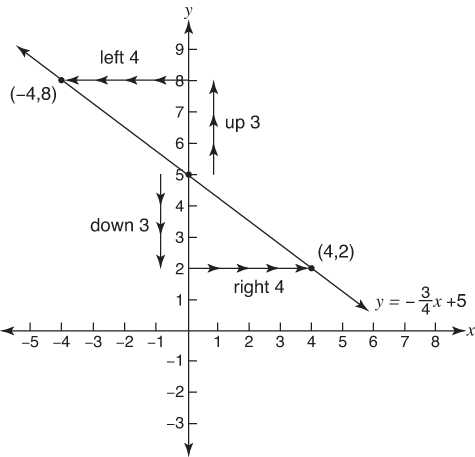Published On:Friday, 9 December 2011
Posted by Muhammad Atif Saeed
Equations of Lines
Equations of Lines
Equations involving one or two variables can be graphed on any x–y coordinate plane. In general, it is true that- if a point lies on the graph of an equation, then its coordinates make the equation a true statement, and
- if the coordinates of a point make an equation a true statement, then the point lies on the graph of the equation.
| x + y = 0 | 3x – 4y = 9 | x = –6 | y = 7 |
|---|---|---|---|
| A = 1 | A = 3 | A = 1 | A = 0 |
| B = 1 | B = –4 | B = 0 | B = 1 |
| C = 0 | C = 9 | C = –6 | C = 7 |
- Standard form. The form Ax + By = C for the equation of a line is known as the standard form for the equation of a line.
- x-intercept. The x-intercept of a graph is the point at which the graph will intersect the x-axis. It will always have a y-coordinate of zero. A horizontal line that is not the x-axis will have no x-intercept.
- y-intercept. The y-intercept of a graph is the point at which the graph will intersect the y-axis. It always has an x-coordinate of zero. A vertical line that is not the y-axis has no y-intercept.
Example 1
Draw the graph of 2 x + 3 y = 12 by finding two random points.To do this, select a value for one variable; then substitute this into the equation and solve for the other variable. Do this a second time with new values to get a second point.
Let x = 2; then find y.
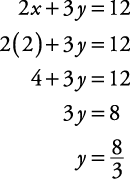
 belongs on the graph.
belongs on the graph. Let y = 6; then find x.
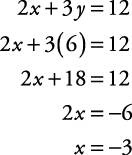
As shown in Figure 1, graph these points and then connect them to make the line that represents the graph of 2 x + 3 y =12.
Figure 1. 2 x +3 y = 12.

Example 2
Draw the graph of 2 x + 3 y = 12 by finding the x-intercept and the y-intercept.The x-intercept has a y-coordinate of zero. Substituting zero for y, the resulting equation is
2 x + 3(0) = 12
Now, solving for x, 
The y-intercept has an x-coordinate of zero. Substituting zero for x, the resulting equation is
2(0) + 3 y = 12
Now, solving for y, 
The line now can be graphed, as shown in Figure 2, by plotting these two points and drawing the line they determine.
Notice that Figures 1 and 2 are exactly the same. Both are the graph of the line 2 x + 3 y = 12.
Figure 2. x- and y-intercepts.
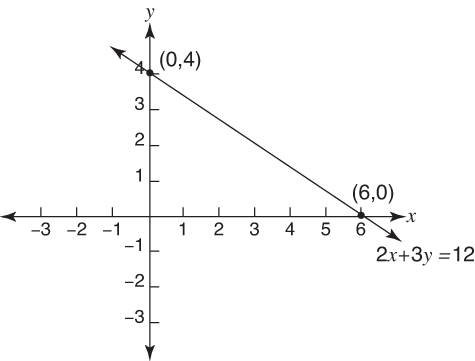
Example 3
Draw the graph of x = 2.As shown in Figure 3, x = 2 is a vertical line whose x-coordinate is always 2.
Figure 3. x = 2 for all y values.
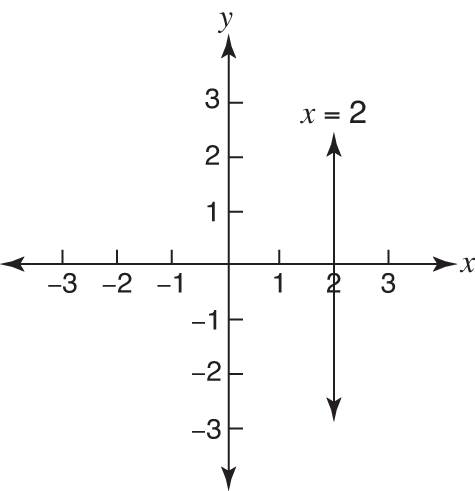
Example 4
Draw the graph of y = –1.As shown in Figure 4, y = –1 is a horizontal line whose y-coordinate is always –1.
Suppose that A is a particular point called ( x1, y1) and B is any point called ( x, y). Then the slope of the line through A and B is represented by

y – y1 = m( x – x1)
This is the point-slope form of a nonvertical line. Figure 4. y = –1 for all x values.
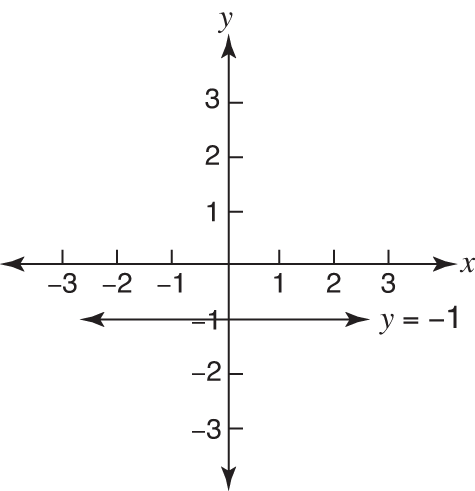
Example 5
Find the equation of the line containing the points (–3,4) and (7,2) and write the equation in both point-slope form and standard form.For the point-slope form, first find the slope, m.
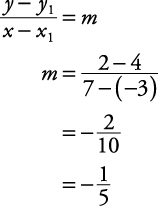


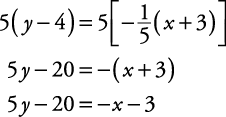
x + 5 y = 17
A nonvertical line written in standard form is Ax + By = C, with B ≠ 0. Solve this equation for y. 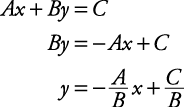
 becomes the slope of the line, and
becomes the slope of the line, and  becomes thev y-intercept value. If
becomes thev y-intercept value. If  is replaced with m and
is replaced with m and  is replaced with b, the equation becomes y = mx + b. This is known as the slope-intercept form of a nonvertical line.
is replaced with b, the equation becomes y = mx + b. This is known as the slope-intercept form of a nonvertical line. Example 6
Find the slope and y-intercept value of the line with the equation 3 x – 4 y = 20.Solve for y.
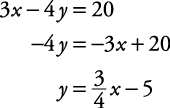
 , and the y-intercept value is –5.
, and the y-intercept value is –5. Example 7
Draw the graph of the equation .
. The equation is in slope-intercept form. The slope is
 , and the y-intercept is (0,5). From this, the graph can be quickly drawn. Because the slope is negative, the line is slanting to the upper left/lower right. Begin with the y-intercept (0,5) and use the slope to find additional points. Either go up 3 and left 4 or go down 3 and right 4. Now, label these points and connect them. Look at Figure 5.
, and the y-intercept is (0,5). From this, the graph can be quickly drawn. Because the slope is negative, the line is slanting to the upper left/lower right. Begin with the y-intercept (0,5) and use the slope to find additional points. Either go up 3 and left 4 or go down 3 and right 4. Now, label these points and connect them. Look at Figure 5. 








